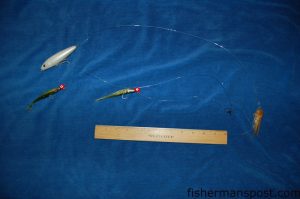Pro Angles Offshore – Capt. Russell Weaver

The Stalker (above) and Double Trouble (below) rigs offer Atlantic bonito and light-tackle anglers a pair of fresh new ways to connect with one another.
With the hotly anticipated arrival of Atlantic bonito (and later spanish mackerel) just around the corner at nearshore structure like the Liberty Ship off Masonboro Inlet, Diver’s Rock out of New River, and artificial reefs and live bottoms up and down the coast, now is the time to gear up for the tasty little tunas.
Sure, you can catch them trolling diving plugs or spoons and casting metal jigs, but Capt. Russell Weaver, of Living Waters Guide Service out of Wilmington, has a few suggestions for light tackle anglers who’d like a fresh way to fool the fish, especially on days when the conventional approaches aren’t producing the expected results.
“Here are a couple options,” Weaver explains. “I call the first the Stalker Rig and the second one Double Trouble. I use braided line with both, so I’ll always tie a topshot of 20-25 lb. fluorocarbon between the braid and the lures.”
Occasionally bonito and their cousins, false albacore, are feeding on baitifish so small that fly fishermen have an advantage over anglers using conventional tackle. Weaver’s Stalker rig allows anglers to present a fly on spinning gear.
“I start with a topwater lure like a Zara Spook or Pop-R and modify it,” he continues. “I leave the front hook on, but remove the back hook, then tie on 18-24” of 20 lb. fluorocarbon and a fly. With the front hook still on the plug, you have a chance to hook the fish that strike the plug and not the fly.”
The topwater lure serves a dual purpose—giving anglers enough weight to cast the fly on conventional tackle and making a surface disturbance that draws in the predators.
“The plug will attract the fish with noise and commotion,” Weaver says, “while the fly poses as an injured or lingering baitfish or a piece of an already struck baitfish.”
Weaver uses a variety of flies until he finds one that the fish show a preference for.
“The fly choice can vary based on whether you’d like the fly to remain on the surface or sink a little bit. I tend to have one of each tied on until I can determine a pattern,” he explains.
The Double Trouble rig provides a complement to the Stalker that lets anglers fish a bit deeper in the water column if necessary.
“The Double Trouble works for numerous fish,” Weaver explains. “I use them for bonito and spanish mackerel, drum, trout, and more.”
The rig starts with a small 30 lb. three-way swivel attached to Weaver’s ever-present 20-25 lb. fluorocarbon topshot.
“I’ll tie two sections of 20 lb. fluorocarbon to the swivel,” he says, “one around 6-10” long and the other 16-20”. I finish off the rig by tying a 1/8 or 1/4 oz. jighead to each section of fluorocarbon.”
Each jighead is finished with a soft plastic tail, which is key to the rig’s versatility.
“The rig allows you to quickly match the size of the baitfish that are present by changing out the grubs,” Weaver reports. “I usually start out with a pair of 4” Gambler Flappin’ Shads, but any grub you have confidence in will work.”
Anglers have the option of casting or trolling a Double Trouble rig, allowing them to use the same setup to troll and prospect for fish that they do casting to breaking schools and fight fish on much lighter tackle than traditional trolling gear.
“If I start to get cut off a lot while spanish fishing with the rig, I’ll replace the sections of fluorocarbon with light weight Seven Strand braided wire,” Weaver adds.
Adding Stalker and Double Trouble rigs to your Atlantic bonito and spanish mackerel arsenal is sure to put a few more of these delicious pelagics in the fish box this year, along with a few smiles on the faces of anglers using them.
